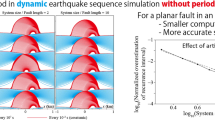Abstract
A numerical algorithm is proposed for the simulation of the earthquake process during a seismic cycle. The algorithm is based on a heterogeneous discrete model of the fault plane and assumes there are two kinds of seismicity: background crack-like earthquakes and asperity-like events. An active zone of the fault contains an asperity distribution with a characteristic elementary area. The background seismicity randomly develops shear stress-free surfaces which tend to surround the asperities as in a 2D percolation process. The model parameters are taken from observations on the Vrancea (Romania) intermediate depth seismic region. The results emphasize the significant role of the geometry in the mechanism of the seismic failure. The algorithm predicts the nonlinear behavior in the frequency-magnitude distribution, the decrease of theb-slope associated with the asperity-like events, the magnitude range of major earthquakes, and their recurrence times.
Similar content being viewed by others
References
Aki, K. (1987),Magnitude-frequency Relation for Small Earthquakes: A Clue to the Origin of f max of Large Earthquakes, J. Geophys. Res.92, 1349–1355.
Cârbunar, F. O. (1991),An Algorithm for a Percolation Process with Constraints, in preparation.
Dieterich, J. H. A model for the nucleation of earthquake slip, InEarthquake Source Mechanics, Maurice Ewing Ser., vol. 37 (eds. S. Das, J. Boatwright, and C. H. Scholz), (AGU, Washington, D.C. 1986) pp. 37–49.
Lomnitz-Adler, J. (1988),The Theoretical Seismicity of Asperity Models: An Application to the Coast of Oaxaca, Geophys. J.95, 491–501.
Main, I. G., andBurton, P. W. (1986),Long-term Earthquake Recurrence Constrained by Tectonic Seismic Moment Release Rates, Bull. Seismol. Soc. Am.76, 297–304.
Mogi, K. (1979),Two Kinds of Seismic Gaps, Pure and Appl. Geophys.117, 1172–1186.
Scholz, C. H., andAviles, C. A. (1986),The fractal geometry of faults and faulting, InEarthquake Source Mechanics, Maurice Ewing Ser., vol. 37 (eds. S. Das, J. Boatwright, and C. H. Scholz) (AGU, Washington, D.C. 1986) pp. 147–155.
Stauffer, D. (1979),Scaling Theory of Percolating Clusters, Phys. Rep.54, 1–74.
Trifu, C-I. (1987),Depth Distribution of Local Stress Inhomogeneities in Vrancea Region, Romania, J. Geophys. Res.92, 13878–13886.
Trifu, C-I. (1990),Detailed Configuration of Intermediate Seismicity in Vrancea Region Rev. Geofis.46, 33–40.
Trifu, C-I., andRadulian, M. (1989),Asperity Distribution and Percolation as Fundamentals of an Earthquake Cycle, Phys. Earth Planet. Inter.58, 277–288.
Trifu, C-I., andRadulian, M. (1991),Frequency-magnitude Distribution of Earthquakes in Vrancea Region: Relevance for a Discrete Model, J. Geophys. Res.96, 4301–4311.
Author information
Authors and Affiliations
Rights and permissions
About this article
Cite this article
Radulian, M., Trifu, CI. & Cârbunar, F.O. Numerical simulation of the earthquake generation process. PAGEOPH 136, 499–514 (1991). https://doi.org/10.1007/BF00878584
Received:
Revised:
Accepted:
Issue Date:
DOI: https://doi.org/10.1007/BF00878584




